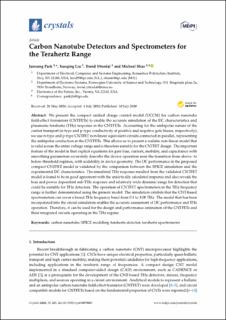| dc.contributor.author | Park, Junsung | |
| dc.contributor.author | Liu, Xueqing | |
| dc.contributor.author | Ytterdal, Trond | |
| dc.contributor.author | Shur, Michael S. | |
| dc.date.accessioned | 2022-05-04T08:41:32Z | |
| dc.date.available | 2022-05-04T08:41:32Z | |
| dc.date.created | 2020-11-05T06:08:30Z | |
| dc.date.issued | 2020 | |
| dc.identifier.citation | Crystals. 2020, 10 (7), . | en_US |
| dc.identifier.issn | 2073-4352 | |
| dc.identifier.uri | https://hdl.handle.net/11250/2994066 | |
| dc.description.abstract | We present the compact unified charge control model (UCCM) for carbon nanotube field-effect transistors (CNTFETs) to enable the accurate simulation of the DC characteristics and plasmonic terahertz (THz) response in the CNTFETs. Accounting for the ambipolar nature of the carrier transport (n-type and p-type conductivity at positive and negative gate biases, respectively), we use n-type and p-type CNTFET non-linear equivalent circuits connected in parallel, representing the ambipolar conduction in the CNTFETs. This allows us to present a realistic non-linear model that is valid across the entire voltage range and is therefore suitable for the CNTFET design. The important feature of the model is that explicit equations for gate bias, current, mobility, and capacitance with smoothing parameters accurately describe the device operation near the transition from above- to below-threshold regimes, with scalability in device geometry. The DC performance in the proposed compact CNTFET model is validated by the comparison between the SPICE simulation and the experimental DC characteristics. The simulated THz response resulted from the validated CNTFET model is found to be in good agreement with the analytically calculated response and also reveals the bias and power dependent sub-THz response and relatively wide dynamic range for detection that could be suitable for THz detectors. The operation of CNTFET spectrometers in the THz frequency range is further demonstrated using the present model. The simulation exhibits that the CNT-based spectrometers can cover a broad THz frequency band from 0.1 to 3.08 THz. The model that has been incorporated into the circuit simulators enables the accurate assessment of DC performance and THz operation. Therefore, it can be used for the design and performance estimation of the CNTFETs and their integrated circuits operating in the THz regime. | en_US |
| dc.language.iso | eng | en_US |
| dc.publisher | MDPI | en_US |
| dc.rights | Navngivelse 4.0 Internasjonal | * |
| dc.rights.uri | http://creativecommons.org/licenses/by/4.0/deed.no | * |
| dc.title | Carbon Nanotube Detectors and Spectrometers for the Terahertz Range | en_US |
| dc.title.alternative | Carbon Nanotube Detectors and Spectrometers for the Terahertz Range | en_US |
| dc.type | Peer reviewed | en_US |
| dc.type | Journal article | en_US |
| dc.description.version | publishedVersion | en_US |
| dc.source.pagenumber | 10 | en_US |
| dc.source.volume | 10 | en_US |
| dc.source.journal | Crystals | en_US |
| dc.source.issue | 7 | en_US |
| dc.identifier.doi | 10.3390/cryst10070601 | |
| dc.identifier.cristin | 1845072 | |
| dc.relation.project | Norges forskningsråd: 237887 | en_US |
| cristin.ispublished | true | |
| cristin.fulltext | original | |
| cristin.qualitycode | 1 | |

